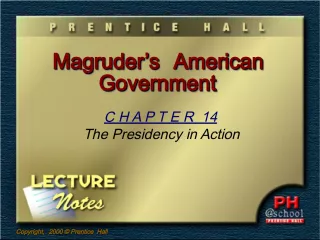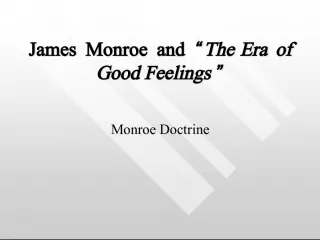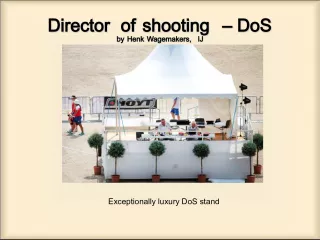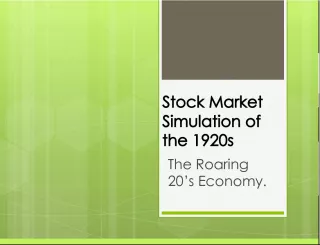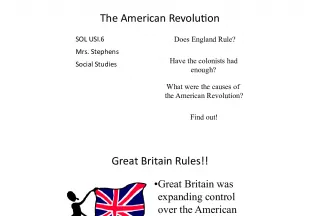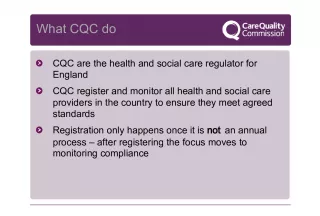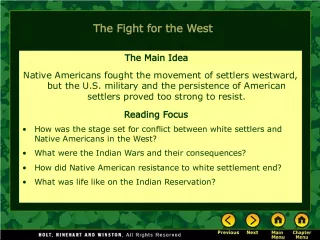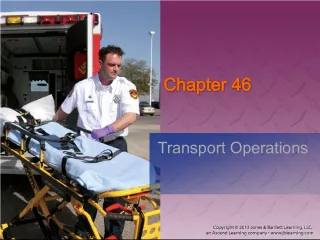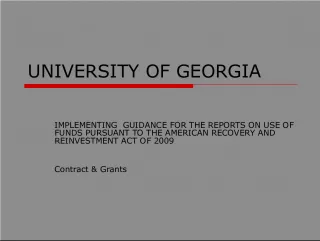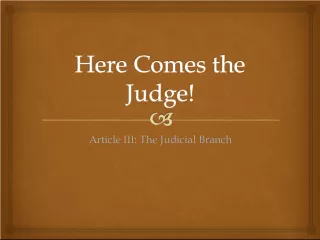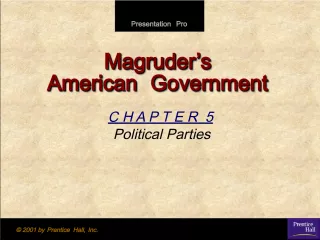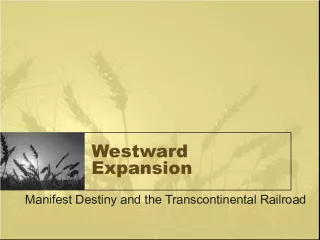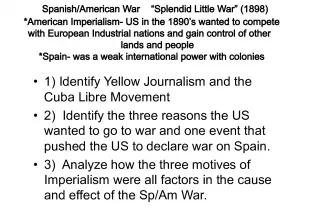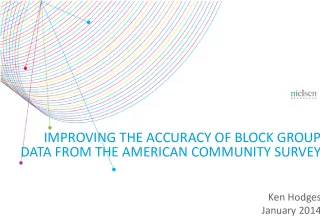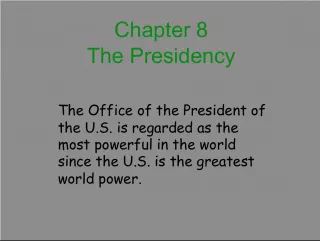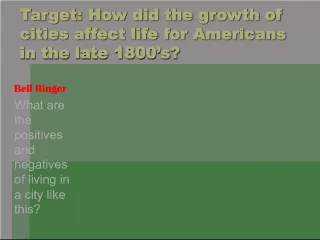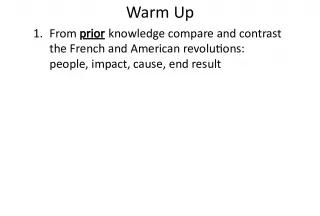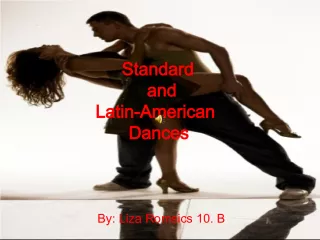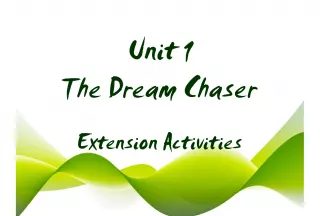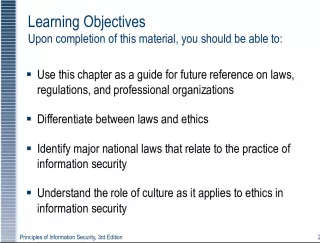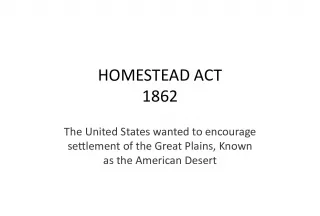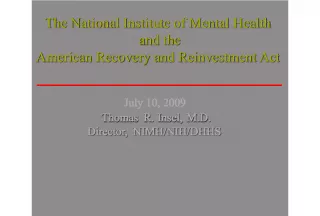The Role and Responsibilities of the American Presidency
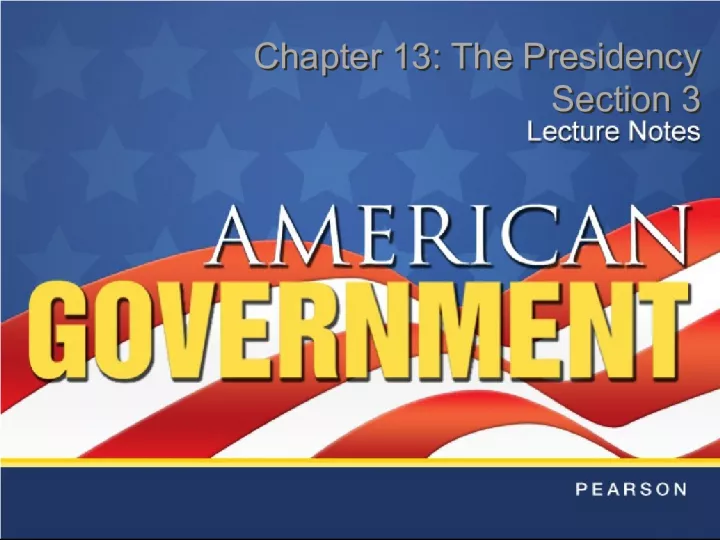

This chapter provides an in-depth look at the American presidency, examining the powers and duties of the president as well as the historical development of the office. Topics covered include the president's relationship with Congress, the role of the president in the international arena, and the presidential election process.
- Uploaded on | 1 Views
-
 phebejacobs
phebejacobs
About The Role and Responsibilities of the American Presidency
PowerPoint presentation about 'The Role and Responsibilities of the American Presidency'. This presentation describes the topic on This chapter provides an in-depth look at the American presidency, examining the powers and duties of the president as well as the historical development of the office. Topics covered include the president's relationship with Congress, the role of the president in the international arena, and the presidential election process.. The key topics included in this slideshow are American presidency, presidential powers, presidential responsibilities, Congress, international affairs,. Download this presentation absolutely free.
Presentation Transcript
1. Chapter 13: The Presidency Section 3 Chapter 13: The Presidency Section 3
2. Copyright Pearson Education, Inc. Slide 2 Chapter 13, Section 3 Introduction How did the process of choosing a President change over time? At first electors cast two votes for president, each for a different candidate. The winner became President and the runner-up became Vice President. The 12 th Amendment added separate electoral votes for President and Vice President. Electors also pledged to vote for their partys candidates.
3. Copyright Pearson Education, Inc. Slide 3 Chapter 13, Section 3 The Constitutional Debate The Framers of the Constitution debated whether to have the President chosen by Congress or by the popular vote of the people. Opponents of congressional selection felt it would upset the separation of powers between the executive and legislative branches. Opponents of popular election felt that the people would not know enough about the candidates to make wise choices.
4. Copyright Pearson Education, Inc. Slide 4 Chapter 13, Section 3 The Electoral College The Framers agreed on a plan put forth by Alexander Hamilton. They created the electoral college, a special body of presidential electors representing each state. Each state would have as many electors as it had senators and representatives in Congress. The state legislatures would decide how presidential electors would be chosen in each state.
5. Copyright Pearson Education, Inc. Slide 5 Chapter 13, Section 3 The Electoral College, cont. Each elector would cast two electoral votes, each for a different candidate. The candidate with the most electoral votes would become President. The candidate with the second-most votes would become Vice President. The Framers did not anticipate the rise of political parties competing for the presidency.
6. Copyright Pearson Education, Inc. Slide 6 Chapter 13, Section 3 The Election of 1796 In 1796, the Democratic- Republican candidate Thomas Jefferson finished a close second to Federalist John Adams. Jefferson then became Adamss Vice President, even though they were political rivals.
7. Copyright Pearson Education, Inc. Slide 7 Chapter 13, Section 3 The Election of 1800 In 1800, the Federalists and Democratic- Republicans faced each other again. For the first time, each party nominated two candidates, one for President and one for Vice President. John Adams and Alexander Hamilton formed the Federalist ticket, while Thomas Jefferson and Aaron Burr were the Democratic-Republican candidates.
8. Copyright Pearson Education, Inc. Slide 8 Chapter 13, Section 3 The Election of 1800, cont. Each party also nominated electors who, if chosen, swore to vote for their partys presidential and vice-presidential nominees. In the map at right, the orange areas voted for Adams, the green for Jefferson.
9. Copyright Pearson Education, Inc. Slide 9 Chapter 13, Section 3 The Election of 1800, cont. As per the electoral college rules, each Democratic- Republican elector cast two presidential votes, one for Jefferson and one for Burr. As a result, Burr and Jefferson tied.
10. Copyright Pearson Education, Inc. Slide 10 Chapter 13, Section 3 The Election of 1800, cont. Popular opinion favored Jefferson, who had run as the partys formal presidential candidate. But there was no rule stating that he should win the electoral tie. Instead, it took the House of Representatives 36 separate votes to break the tie and elect Jefferson as President, making Burr the Vice President.
11. Copyright Pearson Education, Inc. Slide 11 Chapter 13, Section 3 The Election of 1800, cont. The 12 th Amendment, ratified in 1804, separates the vice presidential and presidential elections. Each presidential elector now casts one vote for President and one vote for Vice President.
12. Copyright Pearson Education, Inc. Slide 12 Chapter 13, Section 3 Key Terms presidential elector: one of a group of individuals who cast the formal votes that choose the President electoral vote: one of two votes cast by an elector, one for President and one for Vice President electoral college: the group of people chosen from each State and the District of Columbia to formally select the President and Vice President
